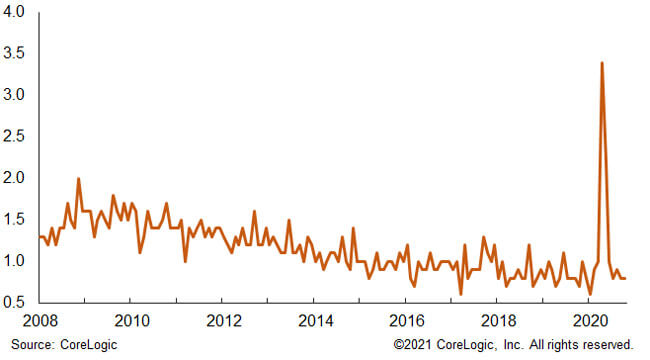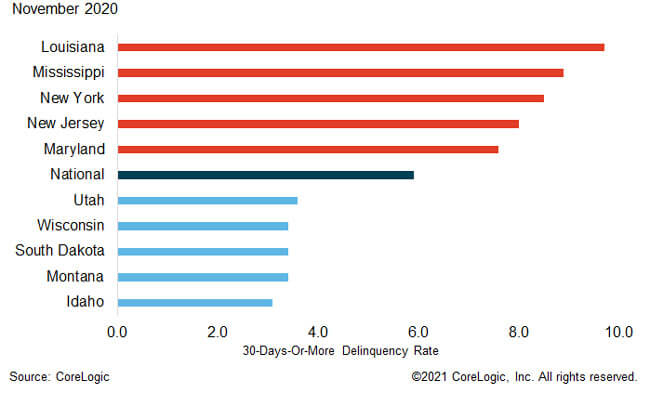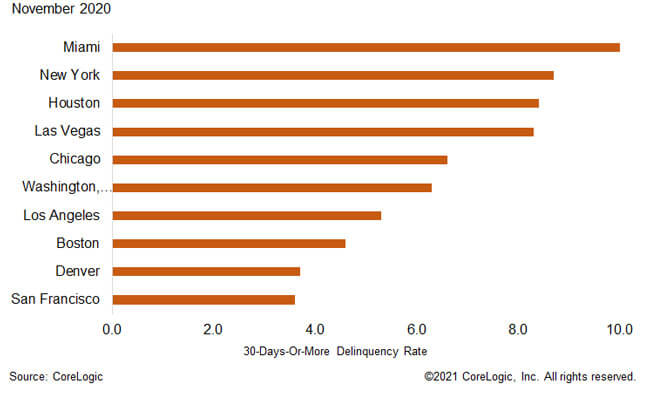Loan Performance Insights Report Highlights: November 2020
- The nation’s overall delinquency rate was 5.9% in November.
- All states logged annual increases in both overall and serious delinquency rates in November.
In November 2020, 5.9% of home mortgages were in some stage of delinquency (30 days or more past due, including those in foreclosure)[1], a small decrease from October 2020, but a 2-percentage point increase from November 2019, according to the latest CoreLogic Loan Performance Insights Report.
Overall Delinquency Rates
The share of mortgages that were 30 to 59 days past due – considered early-stage delinquencies – was 1.4% in November 2020, down sharply from a post-pandemic high of 4.2% in April 2020 and below the year ago rate of 2%. The share of mortgages 60 to 89 days past due was 0.6% in November 2020, unchanged from 0.6% in November 2019 and down from 2.8% in May 2020. The drop in early and mid-stage delinquencies from the spring indicates a lower share of mortgages entering delinquency after the initial surge after the start of the pandemic in the U.S.
The serious delinquency rate – defined as 90 days or more past due, including loans in foreclosure – was 3.9% in November, three times that of November 2019, but this was the lowest rate since May 2020. August’s number (4.3%) represented the highest rate since February 2014. The CARES Act provides relief to mortgage holders and has worked to keep delinquencies from progressing to foreclosure and therefore the foreclosure inventory rate – the share of mortgages in some stage of the foreclosure process – remained low at 0.3% in November 2020, down from 0.4% from November 2019. The decrease in the serious delinquency rate and increases in home equity as prices continued to increase in 2020 lessen the likelihood of a foreclosure wave later in 2021 when homeowners emerge from forbearance.
Stage of Delinquency: Rate of Transition
In addition to delinquency rates, CoreLogic tracks the rate at which mortgages transition from one stage of delinquency to the next, such as going from current to 30 days past due (Figure 1).

The share of mortgages that transitioned from current to 30 days past due held steady at 0.8% in November 2020 – a decrease from the peak of 3.4% in April 2020. The transition rate in November was the same as the monthly average for the 12 months prior to the pandemic, meaning that while the rate of mortgages in any stage of delinquency remained elevated, fewer borrowers slipped into delinquency than early in the recession.

Figure 2 shows the states with the highest and lowest share of mortgages 30 days or more delinquent. In November 2020, that rate was highest in Louisiana at 9.7% and lowest in Idaho at 3.1%. Louisiana, Mississippi and New York were in the top five a year earlier, and all U.S. states posted annual gains in their overall delinquency rate in November 2020. The states that logged the largest annual increases were Hawaii (+4.3 percentage points) and Nevada (+4.2 percentage points).

Figure 3 shows the 30-plus-day past-due rate for November 2020 for 10 large metropolitan areas.[2] Miami had the highest rate at 10% and San Francisco had the lowest rate at 3.6%. Miami’s rate increased 4.9 percentage points from a year earlier. Outside of the largest 10, all but four metros recorded an increase in the overall delinquency rate. Odessa, Texas, experienced the largest annual increase with 9.5 percentage points, likely due to significant job loss in the oil industry. Lake Charles, Lousisiana — which was affected by Hurricane Laura in August and Hurricane Delta in October — had a 9.1 percentage point increase.
© 2021 CoreLogic, Inc. All rights reserved.
[1] Data in this report is provided by TrueStandings Servicing. https://www.corelogic.com/products/truestandings-servicing.aspx. The CARES Act provided forbearance for borrowers with federally backed mortgage loans who were economically impacted by the pandemic. Borrowers in a forbearance program who have missed a mortgage payment are included in the CoreLogic delinquency statistics, even if the loan servicer has not reported the loan as delinquent to credit repositories.
[2] Metropolitan areas used in this report are the ten most populous Metropolitan Statistical Areas. The report uses Metropolitan Divisions where available.


